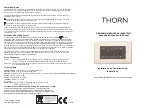
Magnum 6K25e Gigabit Fiber Switch Installation and User Guide (10/07)
15
www GarrettCom com
.
.
2.2.9
Packet Prioritization, 802.1p QOS
Quality of Service means providing consistent predictable data delivery to
users from datagram paths that go all across a network. As a LAN device, the Magnum
6K25e can do its part to prevent any QOS degradation while it is handling Ethernet
traffic through its ports and buffers.
The Magnum 6K25e switching hardware supports the IEEE 802.1p standard
and fulfills its role in support of QOS, giving packet processing priority to priority tagged
packets according to the 802.1p standard. In addition to hardware support for QOS, the
MNS software (R2) supports two priority queues that can be shared across the eight
levels of defined packet priorities for application-specific priority control by the user
through software configuration settings.
2.2.10 Frame Buffering and Flow Control
Magnum 6K25e’s are store-and-forward switches. Each frame (or packet) is
loaded into the Switch’s memory and inspected before forwarding can occur. This
technique ensures that all forwarded frames are of a valid length and have the correct
CRC, i.e., are good packets. This eliminates the propagation of bad packets, enabling all
of the available bandwidth to be used for valid information.
While other switching technologies (such as "cut-through" or
"express") impose minimal frame latency, they will also permit bad frames to propagate
out to the Ethernet segments connected. The "cut-through" technique permits collision
fragment frames (which are a result of late collisions) to be forwarded which add to the
network traffic. Since there is no way to filter frames with a bad CRC (the entire frame
must be present in order for CRC to be calculated), the result of indiscriminate cut-
through forwarding is greater traffic congestion, especially at peak activity. Since
collisions and bad packets are more likely when traffic is heavy, the result of store-and-
forward operation is that more bandwidth is available for good packets when the traffic
load is greatest.
When the Magnum 6K25e Switch detects that its free buffer queue space is
low, the Switch sends industry standard (full-duplex only) PAUSE packets out to the
devices sending packets to cause “flow control”. This tells the sending devices to
temporarily stop sending traffic, which allows a traffic catch-up to occur without
dropping packets. Then, normal packet buffering and processing resumes. This flow-
control sequence occurs in a small fraction of a second and is transparent to an observer.
Another feature implemented in Magnum 6K25e Switches is a collision-based flow-
control mechanism (when operating at half-duplex only). When the Switch detects that
















































